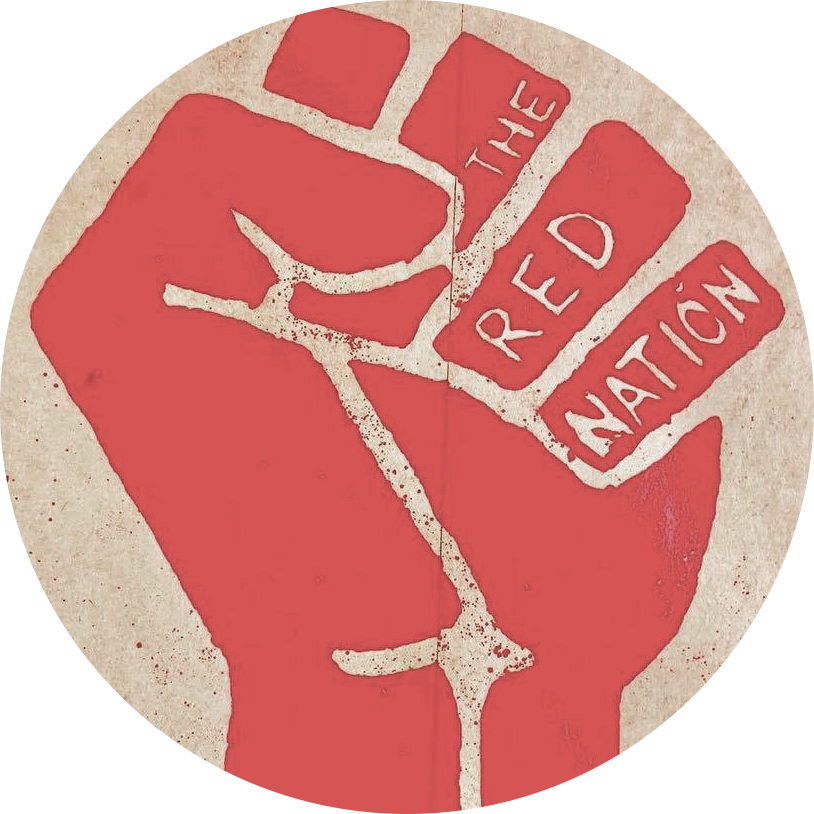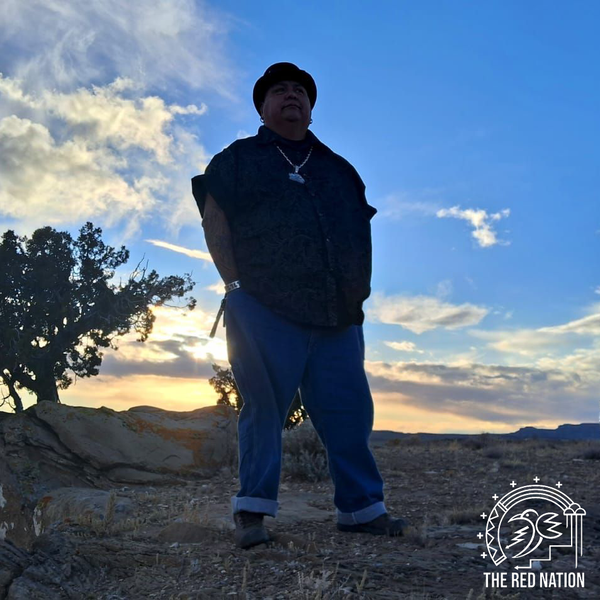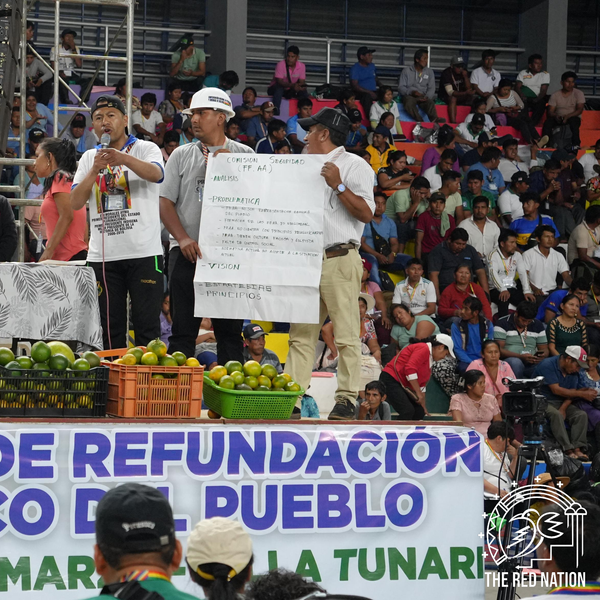The Red Deal-September 2019 Draft

A RED DEAL: INDIGENOUS ACTION TO SAVE THE EARTH
**DOWNLOADABLE VERSION HERE: A RED DEAL**
TAKE ACTION
The Red Nation (TRN) invites allied movements, comrades, and relatives to join us for a series of listening sessions and workshops to draft and implement the Red Deal, a movement-oriented document for climate justice and grassroots reform and revolution.
We are drafting a skeleton outline of a comprehensive Red Deal platform that we will discuss and debate in the course of several community-wide meetings. This will not be a regional- or nation-specific document, but a document that will encompass the entirety of Indigenous America, which includes our non-Indigenous comrades and relatives who live here. This is a document so that our planet may live. We cannot expect politicians to do what only mass movements can do. Join us as we build this movement! No skirts required. All are welcome. Skoden!
BACKGROUND
The proposed Green New Deal (GND) legislation is a step in the right direction to combat climate change and to hold corporate polluters responsible. A mass mobilization, one like we’ve never seen before in history, is required to save this planet. Indigenous movements have always been at the forefront of environmental justice struggles.
Democratic socialist congresswoman Alexandria Ocasio-Cortez, the main proponent of the GND, is herself a Water Protector who began her successful congressional run while she was at Standing Rock protesting the construction of the Dakota Access Pipeline. Thus, the GND and the climate justice movement in North America trace their origins to Indigenous frontline struggles.
With this background in mind, TRN is proposing a Red Deal. It’s not the “Red New Deal” because it’s the same “Old Deal”—the fulfillment of treaty rights, land restoration, sovereignty, self-determination, decolonization, and liberation. Ours is the oldest class struggle in the Americas; centuries-long resistance for a world in which many worlds fit. Indigenous peoples are best suited to lead this important movement. But it must come from the ground-up.
THE RED DEAL
The Red Deal is not a counter program of the GND. It’s a call for action beyond the scope of the US colonial state. It’s a program for Indigenous liberation, life, and land—an affirmation that colonialism and capitalism must be overturned for this planet to be habitable for human and other-than-human relatives to live dignified lives.
The Red Deal is not a “deal” or “bargain” with the elite and powerful. It’s a deal with the humble people of the earth; a pact that we shall strive for peace and justice and that movements for justice must come from below and to the left. We do not speak truth to the powerful. Our shared truth makes us powerful. And this people’s truth includes those excluded from the realms of power and policy-making.
In the spirit of being good relatives, the Red Deal is a platform that calls for demilitarization; police and prison abolition; abolishing ICE; tearing down all border walls; Indigenous liberation, decolonization, and land restoration; treaty rights; free healthcare; free education; free housing; full citizenship and equal protection to undocumented relatives; a complete moratorium on oil, gas, coal, and carbon extraction and emissions; a transition to an economy that benefits everyone and that ends the exploitation of the Global South and Indigenous nations for resources; safe and free public transportation; restoration of Indigenous agriculture; food sovereignty; restoration of watersheds and waterways; denuclearization; Black self-determination and autonomy; gender and sexual equality; Two-Spirit, trans*, and queer liberation; and the restoration of sacred sites.
Thus the Red Deal is “Red” because it prioritizes Indigenous liberation, on one hand, and a revolutionary left position, on the other. It is simultaneously particular and universal, because Indigenous liberation is for everybody.
Where will we get the resources to achieve these monumental tasks? We call for a divestment away from the police, prisons, and military (two of the largest drains on “public spending”) and fossil fuels and a reinvestment in common humanity for everyone (health, wellbeing, and dignity) and the restoration of Indigenous lands, waters, airs, and nations.
PRINCIPLES
Principle #1: What Creates Crisis Cannot Solve It
We’ve all heard the term “divestment.” It was a popular strategy during the NoDAPL uprising in 2016; water protectors called upon the masses to divest from the financial institutions investing in the pipelineg. Why would we need to divest from the pipeline, and the fossil fuel industry more generally? Because it causes widespread harm to people and the planet and, most acutely, Indigenous peoples. The Red Deal continues this call for divestment from fossil fuel industries, but we go one step further. We draw from Black abolitionist traditions to call for divestment away from the criminalizing, caging, and harming of human beings AND divestment away from the exploitative and extractive violence of fossil fuels.
But, divestment is only half of the equation. What will we do with the resources that will become available once we divest from prisons, the military, the detention industry, and fossil fuels? As of 2015, military spending accounted for upwards of 54% of all discretionary spending at the federal level. Proposed discretionary spending for national security in 2020 comes in at $750 billion, $718.3 billion of which is slotted specifically for the US military. In a given year, the US provides $3.8 billion in military aid to Israel. $182 billion is spent each year on cops and prisons. And eight white dudes—all except one an American citizen—own over half the world’s wealth. This doesn’t even include the revenues from the fossil fuel industry.
Compare this to the $68 billion allocated for education in 2016 and the $186 billion allocated for mental health services in 2014. And only $66 billion of discretionary funds are spent on healthcare each year, with $5.4 billion allocated to IHS. Despite this massive allocation of resources, healthcare is still unaffordable for almost half of Americans. Despite treaty and federal obligations, Native people (especially those living in urban locations) experience the worst healthcare. Corporations like the pharmaceuticals industry control public services through lobbying. Despite these already low numbers, the US government is threatening to cut spending on education, healthcare, food stamps, and other crucial health and human services in order to further inflate military spending. Imagine if we had over a trillion dollars to invest in healthcare for everyone? To increase teachers’ pay so they can provide quality, free education to everyone? To repair roads and provide safe and accessible public transportation for everyone? To invest in large-scale language revitalization programs in every Indigenous nation on the continent?
Imagine if the US military had to hold a bake sale to keep its doors open instead of preschools, domestic violence shelters, art and language programs, and family planning clinics? This proves there is an overabundance of energy and resources that go into demonizing Indigenous water protectors and land defenders, Muslims, Black people, Mexicans, women, LGTBQIA2+, and poor people. While climate change receives barely a sliver of attention. With the resources we gain from divestment, we could end world hunger, illiteracy, child hunger, homelessness, and build renewable energy tomorrow.
Principle #2: Change From Below And to The Left
The flurry of anti-protest laws that have been considered in dozens of states in the wake of Black Lives Matter and NoDAPL proves that the people themselves and their demands for a dignified life threaten the powerful. It has been forgotten that the current Green New Deal (GND) legislation was only possible because its main advocate, Alexandria Ocasio-Cortez, was inspired by the NoDAPL uprising. Indigenous people are, and have always been, at the forefront of the struggle for climate justice.
While politicians withdraw from the social justice demands of the GND like healthcare, housing, and education, we embrace them. But we know that we must go further. We must throw the full weight of people power behind these demands for a dignified life. People power is the organized force of the masses; a movement to reclaim our humanity and rightful relations with our earth. With this, not only will we topple power, but we will build a new world from the ashes of empire. A world where many worlds fit.
There can be no rich people without poor people; the rich depend upon the poor. But the poor don’t need the rich. This is our power. Although Indigenous peoples live in a capitalist society, we continue to practice people power. For example, Pueblo communities feed for nearly every ceremonial event. The original purpose of this was to pry surplus from those who held more wealth and redistribute it amongst those who didn’t so that neither a poor class nor a ruling class could form. Everyone’s material needs were met; there was no starvation, no homelessness, no alienation. Everyone was a relative, and everyone had relatives. Capitalism destroyed this world. We must destroy capitalism to bring it back.
People power is the most direct form of democracy. Everyday people decide what’s best for themselves, not the elite and powerful. The wealthiest in the world have refused to pay taxes for more than a century while Indigenous people starve and die of preventable diseases. We believe that crying on the shoulder of the man who stole your land is the opposite of people power. You can’t smudge the murder out of capitalism, nor can you expect the powerful to give up their wealth out of the kindness of their hearts. So how do we get things to change? Lobby Congress and politicians? No. We reach out directly to our people, hitting the streets and galvanizing the support of the community. Once community support is galvanized, politicians will follow. Our leverage is people. Leverage comes from a movement behind you. Only when people move, do we build enough power to force concessions and eventually win.
Principle #3: Politicians Can’t Do What Only Mass Movements Do
Everyone has heard the term “reform.” Politicians use it all the time when they’re describing their plans for social change. We believe in reform, too. But we’re proposing a different kind of reform. Reform typically means asking the powerful to implement gradual changes that we hope will eventually improve our lives. This approach attempts to treat the symptoms of a crisis, rather than the structures of power that create crisis in the first place. For example, in March 2016, white police officer Austin Shipley’s lapel camera captured his murder of 27-year old Navajo mother Loreal Tsingine in broad daylight in Winslow, Arizona. Lapel cameras are often cited by police reformers as a necessary deterrent to police violence and killing. Shipley murdered Tsingine with impunity and faced no charges.
In the same year that Tsingine was murdered, police arrested over 800 Water Protectors and brutalized and traumatized countless others at Standing Rock. That same year, police killed Native people at higher rates than any other group and killed Native women at six times the rate of white women. Yet, when proponents call for MMIWG “reform,” the solution is more police to address the killing, rape, torture, and imprisonment of Native women.
And in 2018 and 2019, we saw an increase in deaths of Indigenous children in migrant detention centers along the US-Mexico border. We witnessed the shooting by US border patrol of Claudia Patricia Gómez González, an Indigenous woman from Guatemala. And we mourned the death of trans Indigenous woman Roxana Hernandez in an ICE detention facility. Immigration reformers have called for border patrol to keep families together and have also filed lawsuits to call for the construction of “more humane” cages for these families and individuals.
The question these reformers ask is: How can we improve the police? Who do we need to lobby to make these improvements? Instead, we ask: Why are police considered the solution to the crisis of Indigenous life? Why do we even need the police? “Chinga La Migra, “Abolish ICE,” and “No Ban on Stolen Land” are not mere slogans but demands for a dignified life. The police, military, and border patrol exist to protect the interests and wealth of the elite. Instead of providing homes, healthcare, and food, all we get are more cops, more soldiers, more walls, more poisoned water, and more cages. The interests of the few always outweigh the needs of the many. This is how power works in a world structured by capitalism.
Reformists misunderstand this fundamental truth about capitalist states. States protect capital and the wealthy class, not life. Reformists who appeal to the state for change compromise our future. We refuse to compromise. Our philosophy of reform is to reallocate social wealth back to those who actually produce it: workers, the poor, Indigenous peoples, the Global South, women, migrants, caretakers of the land, and the land itself. Each of these categories needs special protections. Some examples of the type of reforms we seek include the complete moratorium on oil, gas, and coal extraction. Another is the restoration of Indigenous land, water, and air to a healthy state. These “non-reformist reforms” are crucial to achieving abolition, decolonization, and liberation.
Where will we get the money to fulfill these reforms? By dispossessing the wealth from corporate polluters and settler governments and redistributing it to the masses, creating jobs to caretake and heal the planet and build our collective future.
Principle #4: From Theory to Action
Bosses run the world, from the White House to the highest executives of the multinational corporations that plunder the earth. Yet, there is no unified left that poses a real threat to the bosses. We have witnessed massive grassroots rebellions against the fossil fuel industry, police violence, racist immigration policies, and labor exploitation, yet nothing has coalesced into a unified mass movement. We believe that struggling for these reforms to restore the health of our bodies and the earth will serve as the most powerful vehicle for building a mass movement. We cannot simply be against something; we must be for something.
We will make policy recommendations that can be used at any level of government, from the grassroots to the tribal council to the state. We cannot turn away from the state because the state has its sights set on us at all times. Indigenous people know that every moment of our existence is mediated by the state: it is illegal to give birth in our traditional homes without state permits and we aren’t even allowed to visit our sacred sites that lie within federal lands without proof of identity. The state harasses us wherever we go because we are not supposed to exist; we are supposed to be gone, erased off the lands the US so desperately wants to exploit for profit. Wherever the state and forces of capital set their sights—urban Indigenous youth, women, migrants, Black people, LGBTQAI2+, our sacred mountains and waters–we must agitate and organize. We cannot simply build isolated utopias while the rest of the world burns, nor can we wait for the slow process of reformist reform to kick in. We cannot simply heal our individual trauma, nor can we consume better to save the environment. We cannot vote harder and place all our hope in a few individuals in Congress. Climate change will kill us before any of these strategies liberate the planet from capitalism.
By fighting for non-reformist reforms in and with these communities, we will drain power and resources from surveillance and harm and reinvest these resources in the wellbeing of all. We will fight for the redistribution of the wealth stolen from us, whether it’s land, water, air, or labor. We will do this in such a way that adheres to the philosophies of abolition, decolonization, and anti-capitalism.
We must reclaim our collective power. When the state invests its greatest resources to contain the threat of mass mobilization, we must already be organized in those spaces and those communities. We must be one step ahead, ready to capture the momentum of the next rebellion and catapult it into a full-blown mass movement.
Above all, we seek peace and right relations between all life. Join us in this struggle!
AREAS OF STRUGGLE
End the Occupation: divest from the following police and military institutions
- Defund Police/La Migra/Child Protective Services
- End bordertown violence
- Abolish incarceration (prisons, juvenile detention facilities, jails, border security)
- End the US Military occupation everywhere
- Abolish imperial borders
Heal Our Bodies: reinvest in the following institutions and services
- Citizenship & equal rights for everyone
- Free & sustainable housing for everyone
- Free education for everyone
- Free healthcare for everyone
- Free and accessible public transportation for everyone
- Suicide prevention
- Mental health services
- Healthy, Indigenous, and abundant food for everyone
- Clean water & air
- Sexual and domestic violence services
- End MMIWG2S
- Reproductive justice
Heal Our Planet: create jobs by reinvesting in the following
- Clean, sustainable energy
- Traditional & sustainable agriculture
- Land, water, air, & animal restoration (above and below ground)
- Protect sacred sites
- Free the earth from capitalism
- Multi-species caretaking
- Enforce treaty rights and other agreements
#seizethebanksnottheland
#allstruggleisclimatestruggle
#buildcommonstruggle
#fromthebottomup
#defeatfossilfuels
#inthewayheretostay
#sameolddeal
#beyondTheGND
#protecttheland
#protectthepeople
#nogreencapitalism




